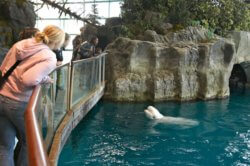Another beluga infant has perished at the Shedd Aquarium in Chicago. This time it is the infant of Naya, a 31-year-old beluga whale who gave birth to premature twins on August 30, 2020. One of the twins was stillborn and the other weighed less than half of normal birthweight. (Twinning is very rare in belugas and other cetaceans, occurring in less than one percent of all births.)

Beluga whale at the Shedd Aquarium – Alamy
In response to the infant’s death, Chief Animal Operations Officer Peggy Sloan stated: “Our team gave Naya’s calf the absolute best chance to thrive.” And while it’s doubtless true that the aquarium did its best, thriving is an unrealistic expectation for any beluga who is born in a concrete tank.
While the low birthweight that comes with twinning may be the basis for this infant’s demise, we should note that the Shedd Aquarium and many other captive facilities are associated with a shockingly high beluga infant mortality rate.
Last year, Shedd announced the successful birth of another infant beluga, this one to Mauyak, a beluga who had been captured in Canada’s Hudson Bay in 1982. The baby survives to this day. But Mauyak had given birth four times previously and only one of those four survives: her six-year-old daughter Kimalu. Of the three others, one was stillborn, one died the same day he was born, and another succumbed to illness at Mystic Aquarium in Connecticut at age nine.
The high mortality rate is not limited to infants and juveniles. The Shedd Aquarium has had 10 beluga deaths in the past 30 years – one death every three years on average. And this history is typical for belugas forced to live in concrete tanks.
There is a fundamental mismatch between life in concrete tanks and the evolutionary make-up of belugas.
At the Georgia Aquarium, six belugas have died in the past 15 years; none lived beyond the age of 26 despite the fact that the natural lifespan for belugas is 50 to 60 years. A female named Maris lost two calves in the span of three years and then died suddenly in 2015 at the age of 21. The cause of her death was never disclosed.
While disease, injury and death are part of life in the ocean as well, it is revealing that they are so common in facilities claiming to offer the best of human care. Something doesn’t add up. And that “something” is the fact that there is a fundamental mismatch between life in concrete tanks and the evolutionary make-up of belugas. Like orcas and other cetaceans, belugas are highly intelligent, wide-ranging, socially complex, cultural beings, whose species-specific needs simply cannot be met in tanks.
Efforts to facilitate thriving in infant or adult beluga whales living in tanks are inherently doomed to failure. They need space to travel and depth to dive, the opportunity to live in a rich supportive social network of friends and family, the ability to explore a dynamic environment filled with interesting objects and other animals, and the ability to make their own choices on a daily basis. None of these fundamental aspects of well-being exist at marine entertainment parks and aquariums.
The only ethical response to this kind of suffering and loss is to call a halt to the breeding. Canada took this important step in 2019 when it passed Senate Bill S-203. This legislation bans the display of dolphins and whales for entertainment and, importantly, makes it illegal to continue to breed them. Banning breeding is not only the compassionate response to the continued mortality, but also the first step toward a more progressive relationship between humans and beluga whales.
Instead of continuing to try to save “depleted collections” of belugas in captivity, it’s time for marine parks and aquariums to join the growing movement to retire these animals to permanent sanctuaries. In a seaside sanctuary they can be cared for while enjoying aspects of a natural life they are denied in the tanks. While not equivalent to a natural free-ranging life, a sanctuary provides much more of what belugas need in order to thrive: substantially more space, a more interesting and varied environment, and the opportunity to exercise their autonomy and spend their days doing whatever they want and associating with whomever they want.
Nature is sending a clear message to those who continue to try to make the concrete tanks work at the expense of the well-being and lives of belugas and other cetaceans. And the only informed response is Back to Nature.